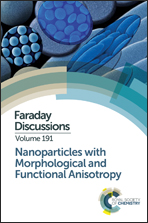Numerical analysis of Pickering emulsion stability: insights from ABMD simulations†
Abstract
The issue of the stability of Pickering emulsions is tackled at a mesoscopic level using dissipative particle dynamics simulations within the Adiabatic Biased Molecular Dynamics framework. We consider the early stage of the coalescence process between two spherical water droplets in a decane solvent. The droplets are stabilized by Janus nanoparticles of different shapes (spherical and ellipsoidal) with different three-phase contact angles. Given a sufficiently dense layer of particles on the droplets, we show that the stabilization mechanism strongly depends on the collision speed. This is consistent with a coalescence mechanism governed by the rheology of the interfacial region. When the system is forced to coalesce sufficiently slowly, we investigate at a mesoscopic level how the ability of the nanoparticles to stabilize Pickering emulsions is discriminated by nanoparticle mobility and the associated caging effect. These properties are both related to the interparticle interaction and the hydrodynamic resistance in the liquid film between the approaching interfaces.
- This article is part of the themed collection: Nanoparticles with Morphological and Functional Anisotropy

 Please wait while we load your content...
Please wait while we load your content...